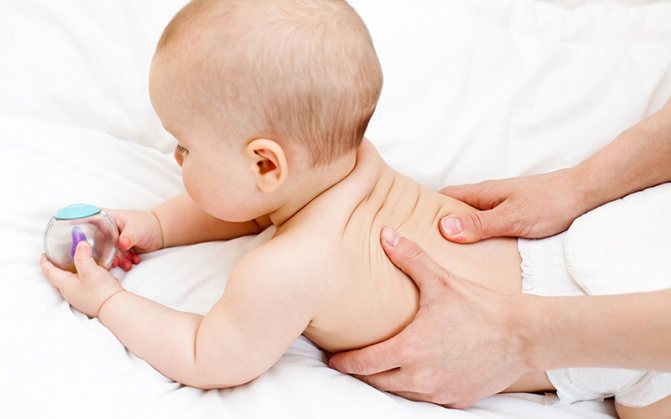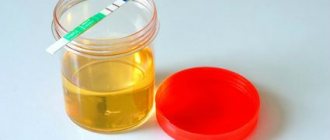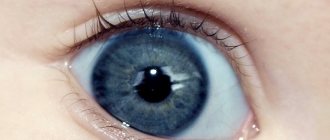Babies are born with increased muscle tone due to the position of the embryo in the womb. It is the fetal position that is the main sign of increased tone after birth - the arms are bent at the elbows, the knees are pulled closer to the tummy, the hands are clenched into fists, and the head is slightly thrown back. If you try to straighten your baby's legs and arms, you will feel a lot of resistance. Typically, increased muscle tone in infants lasts about 3 months, then gradually decreases.
Many mothers, being sure that increased tone is the norm for all newborns, do not pay much attention to this and thus make a mistake. The fact is that the muscle tone of a newborn is a direct reflection of the state of the nervous system and general well-being. If a baby’s muscle hypertonicity does not go away during the first 3-6 months of life, this may mean that there are some deviations or disturbances in the body’s functioning. And if you do not immediately begin to resolve this issue, there is a high risk that the child will lag behind in development.
During examinations, pediatricians always observe the baby’s posture and how he moves. The doctor holds the child horizontally in the air upside down and if the head is in line with the body, and the legs and arms are pulled towards him, then there is increased muscle tone.
Parents can also notice hypertonicity in a newborn - the baby does not relax, even when sleeping.
The opposite state of hypertonicity is hypotonicity. Hypotonia is characterized by the so-called “frog pose” - the knees are turned to the sides, the arms are outstretched. This condition is also dangerous for the further development of the child.
But you shouldn’t worry - if you consult a doctor in time and prescribe treatment, nothing bad will happen.
Methods for determining muscle tone
There are several ways to understand what muscle tone a newborn has.
Pulling on Handles
Place the child on a hard, flat surface, grasp his hands and gently pull them towards you. If his elbows are calmly straightened and his stomach sticks out when sitting, it means he has low muscle tone (hypotonicity). If the elbows still do not straighten, then this is increased muscle tone (hypertonicity).
Tonic reflex
The tonic reflex is a natural reaction of the flexor and extensor muscles to changes in body position. For example, if you place a child on a hard, flat surface, he will begin to “open up,” i.e. try to straighten his limbs, and when you turn him over on his tummy, then, on the contrary, he will begin to “close up”. If there is no reaction to such positions, then this is hypotonicity. If such a reaction persists in a child older than 3 months, then this is hypertonicity.
Symmetrical and asymmetrical reflex
A symmetrical and asymmetrical reflex should normally persist in a newborn for up to 3 months. Place the baby on his back, and your palm on the back of his head and slightly tilt his head towards his chest - the baby should straighten his legs and bend his arms. Now turn your head to your right shoulder - the baby should extend his right arm forward, straighten his right leg, and bend his left. Now turn your head to your left shoulder - the baby should repeat the same thing in a “mirror” version. Absence of the reflex - hypotonicity, persistence of the reflex after 3 months - hypertonicity.
Support reflex
Take the baby under the arms and try to put him on his feet on the changing table, slightly tilting him forward, as if pushing him to take a step forward. Normally, the baby should rest on a flat foot with straightened toes. If the baby refuses to walk or instead of standing, he crouches, it means he has hypotension. If the baby rests only on his toes instead of a straight foot, it means he has hypertonicity.
Constipation in a newborn. Let's solve the problem.
In the life of every baby, sometimes this unpleasant situation occurs when bowel movements become rare, the feces are dense, and its passage can even be painful. We're talking about constipation.
What should be the frequency of a child's stool? If the baby is breastfed, then at least twice a day, in the case of formula feeding - at least once a day. In the second case, children more often suffer from constipation.
Causes of constipation:
a) related to nutrition
- monotonous nutrition of the child and mother, low content of fruits and vegetables in the mother’s menu;
- underfeeding the baby;
- incorrect introduction of complementary foods;
— non-compliance with proportions in preparing the mixture;
- low fluid intake by the baby;
- iron deficiency.
b) developmental features
— anatomical features and congenital malformations of the gastrointestinal tract;
- spasm of the anal sphincter;
- hypothyroidism;
- cracks and inflammatory changes in the anus;
c) insufficient child care
— uncomfortable conditions (cold potty, wet diapers, etc.;
- motor mode is insufficient.
It also happens that constipation in a newborn combines several causes of stool retention.
Constipation in newborns and children in the first months of life occurs due to spasm of the anal sphincter in combination with poor nutrition of the mother. The baby feels discomfort and pain in the abdomen, so he is capricious and worried.
If, when palpating the abdomen, one of the sections of the large intestine is detected in the form of a dense cord, immediately consult a doctor.
What treatments for constipation can help my baby? How to treat constipation?
Try to relieve your newborn's condition by using the following methods to treat constipation:
- stroking the tummy clockwise;
- regular gymnastics, massage, laying the baby on his stomach;
- flexion and extension of the baby’s legs;
- taking a warm bath;
— careful stimulation of the anus using a gas tube (in exceptional cases, extremely rarely);
- use of an enema. Like the previous one, this method must be used if other methods have not helped, since frequent enemas suppress the urge to defecate. To treat urge cessation, it will be necessary to use medication.
Treatment of constipation should be comprehensive. Constipation in a newborn can be a consequence of poor nutrition of the mother and child.
From the mother's diet it is necessary to exclude foods that contribute to the accumulation of gases in the stomach (cabbage, black bread, mushrooms, grapes and others). It is also necessary to reduce the amount of animal fat in a nursing mother’s diet and partially replace it with vegetable fat. Eating foods high in dietary fiber (porridge, fruits and vegetables, wholemeal bread and others) will contribute to the formation of a laxative effect. Foods that cause constipation in a newborn may be a manifestation of a food allergy, in which case they should be excluded from the diet of a nursing mother. The introduction of prebiotics and probiotics into the diet has a beneficial effect on eliminating the problem. Newborns who are bottle-fed are introduced to the diet with special mixtures containing lactulose and carob gluten, which ensure normalization of stool. With the introduction of complementary foods, the baby is given juices from carrots, prunes, and beets, which help enhance peristalsis.
A few words about the use of an enema.
Trying to cure constipation in a newborn with an enema can create an even bigger problem. Regular enemas suppress the natural impulse to defecate, and the baby is no longer able to cope with the problem on his own. If stool retention is caused by low contractile activity of the intestine, drug treatment will be required.
Treatment of hypertension in a newborn
Treatment depends on the specific situation, but usually neurologists
Prescribe therapeutic relaxing massage for newborns for 10 sessions, repeated every six months. Swimming, electrophoresis and therapeutic exercises are also prescribed. In more serious cases, medications may be prescribed to reduce muscle tone, as well as B vitamins.
You can do massage and gymnastics yourself at home - just perform a few simple manipulations. For example, you can put the baby on his back, take him by the hands and shake him a little from side to side, as if relaxing the muscles in the arms and shoulders. Do the same with your legs. You can also put the baby on his stomach and stroke his back - first with your fingertips, then with your entire palm.
Remember that newborns with hypertonicity cannot be given a regular massage such as patting and diligent kneading of muscles. Also avoid walkers - they only aggravate the condition of hypertonicity.
Treatment of muscle hypotonia

The main approaches to the treatment of this disorder differ depending on the etiological factor. Treatment of hypotension can be carried out both at home and on an outpatient basis. In some cases, hospitalization in a hospital is necessary.
Treatment of muscle hypotension in infants should begin with massage. It must be reflexive in nature and performed exclusively by a qualified specialist.
Massage for hypotension has a stimulating effect. In a newborn, the muscles have not yet fully formed, so it is easy to influence their functions with the help of a chiropractor.
Physiotherapeutic techniques, such as electrophoresis and magnetic therapy, are widely used. With their help, you can restore the normal response of muscle fibers to a nerve impulse. Since the invasiveness of the procedure is of great importance for a newborn, electrophoresis is excellent as a painless and non-invasive method that does not cause side effects.
In addition, electrophoresis has a number of positive effects without the mandatory use of pharmacological drugs. Treatment with this method has an overall beneficial effect on the metabolism of the tissues under the skin.
Electrophoresis normalizes metabolism, dilates blood and lymphatic vessels, ensuring blood flow. Also, using the influence of an electric field, it is possible to reduce inflammatory processes and normalize the function of the endocrine glands.
Electrophoresis is often used together with pharmacological drugs to treat muscle hypotonicity. Thus, the effect of the administered drugs will increase due to the close proximity to the site of the pathological process.
The advantage of electrophoresis is that the baby does not feel discomfort during this procedure and administering medications is much easier than, for example, using injections or droppers.
An important role in the treatment of hypotension in a child is played by outdoor games, which are aimed at developing gross and fine motor skills; special exercises train muscle function and restore muscle function.
If muscle hypotonia in children is caused by metabolic diseases, the concentration and quantity in the body should be adjusted. The lack of vitamins and microelements can be compensated for with special complex preparations.
Pharmacotherapy is presented in the form of nootropics and neurometabolic agents. Its appointment must be supervised by a qualified specialist.
Muscular hypotension in children can be a symptom of a serious illness, so every parent should know how to recognize hypotension or suspect the prerequisites for its development in their child. As with many other diseases, the rule applies: the earlier treatment is started, the more effective it will be.
Increased leg tone in a child Komarovsky
All newborn children, not yet accustomed to the new world for them, strive to be in the fetal position - when the legs are bent, the hands are clenched into fists and pressed to the chin, the head is slightly thrown back - this is how they seem to feel safer.
But two to three months after birth, such behavior should be alarming, because by this age the baby’s muscles should become more developed and flexible.
If the baby is still tense and has a number of characteristic symptoms, then neurologists diagnose “hypertonicity.”
Causes of hypertension in newborns
Each child who is diagnosed with this condition may have individual reasons for the development of hypertonicity. But in general they are:
- hypoxia (oxygen starvation) of the fetus during gestation.
- maternal illnesses during pregnancy.
- chronic diseases of pregnant women.
- rapid or very prolonged labor, in which the baby suffers from either excessive pressure or lack of air.
- incompatibility of Rh factors in parents.
How does hypertension manifest itself?
One of the main symptoms of hypertension is a certain position of the child during sleep. His arms and legs are pressed tightly to his body, his head is tilted forward so that his chin is pressed to his chest. Visually, this position resembles the position of the fetus during pregnancy. If you try to straighten your baby’s arms, he will actively resist, despite being asleep.
Other symptoms of hypertension are:
- the tone of the flexor muscles is higher than that of the extensor muscles
- the child's hands are constantly clenched into fists
- The baby's legs are predominantly bent
- the baby often tries to throw his head back
- baby's sleep is short and restless
- During sleep, the baby may change the position of his body, trying to arch, and his muscles are so tense that they tremble noticeably
- irritation to light and the slightest sounds appears (irritation may be accompanied by frequent shudders)
- the child’s chin often trembles (not only when crying, but also during sleep)
- the appearance of the “stepping” reflex ahead of time (the newborn constantly imitates walking, moving its legs).
- Intermittent restless sleep, during which the child shudders nervously and shakes his head sharply.
- Poor appetite, frequent regurgitation.
- Strange behavior when crying: the baby arches his whole body, his limbs and chin shake. Often, crying begins for no reason.
- When a child is placed on a flat surface with his legs, he does not begin to stomp (which is a normal reflex), but rises on his tiptoes.
- “cradle” exercise (the child should be placed on a flat surface on his stomach, place your palms under the upper and lower parts of his body, lift him a little and rock him slightly from side to side)
- holding the baby by the forearm, you need to lightly shake him with your hand
- holding the baby's thigh, a similar technique should be performed with the feet
- several times you need to smoothly spread the child’s arms to the sides from the chest, alternating the exercise with a similar technique for the legs
- holding the baby's legs by the feet, you should try to gently bend them and straighten them at the knees
- Use your fingers to gently press on the area under the toes (the child’s toes should bend)
- You need to run your fingers along the outside of the foot several times (the toes should straighten).
When performing special massage or gymnastics, hypertonicity disappears after three months of the child’s life. If, upon reaching the age of six months, the increased tone remains, then the baby is prescribed a complex of treatment, and hypertonicity becomes a disease. The main problem during this period is weaning the child from walking “on tiptoe”.
Symptoms of hypertension
So, up to a certain age, muscle tension in a baby is a normal physiological phenomenon, but if it does not go away after 3-3.5 months, it is not normal.
In addition, in addition to constantly constrained muscles of the arms and legs, clenched fists and low flexibility, the following symptoms are observed with hypertonicity:
If the baby has all the signs and the diagnosis of “hypertonicity” is confirmed by the pediatrician, then it is worth remembering that this disorder is not difficult to correct. and it is also important to remain calm, because the nervousness of the parents is transmitted to the child, and can only aggravate his condition.
Treatment of hypertension in infants
Hypertonicity does not belong to the category of diseases, and in a mild form you can do without treatment if the doctor allows it. In many infants, hypertonicity goes away on its own; it was simply present, as a physiological phenomenon, for a longer time than in most children (up to 6 months, for example).
But, unfortunately, there are situations when hypertonicity is quite pronounced and requires treatment, as it can negatively affect the development of the baby as a whole. Typically, pediatricians prescribe massage treatments and gymnastics, and only in exceptional cases - drug therapy.
Massage for hypertension
Carrying out a special relaxing massage helps to effectively cope with the manifestations of hypertension. Most clinics provide referrals to free massage courses if a child is diagnosed or simply suspected of hypertonicity. But for more successful and faster treatment, it’s also a good idea to conduct classes with your baby at home.
An important condition for massage sessions is the baby's calm state. If the child cries, gets nervous, and squirms, then such activities will not bring any benefit, rather they will do harm. Therefore, it is necessary to maintain a stable emotional state of the baby: before each session, talk to him tenderly and feel sorry for him.
During the procedure, the masseuse should try to distract the child with toys (therefore, it is advisable to take them with you to the massage), if, for example, he is afraid of new surroundings and unfamiliar people around.
Perhaps the baby will be able to truly relax from a massage only at home and when performed exclusively by his mother. Then you will have to learn everything that can help your tiny child overcome hypertension, while strictly following all the instructions of doctors and masseuses.
As a rule, one massage session lasts 15-20 minutes, and their total number is up to 15, at least 5 times a week.
Before the procedure, the child’s body is smeared with baby oil for greater comfort and effectiveness of the massage.
First, the baby is carefully stroked, then the muscles of the arms and legs are stretched with increasing intensity (within reason, of course), and each finger is massaged. do a figure eight on the feet, then, turning the baby onto his stomach, stretch the muscles of the back and shoulders.
All movements should be aimed at maximum relaxation, and the baby must enjoy the process - this is the main rule of therapeutic therapy.
If the massage has a beneficial effect, then after just a few sessions there should be a noticeable increase in the child’s motor activity.
Gymnastics for hypertension
Simple gymnastic exercises are recommended for infants not only when identifying hypertension, but also for its prevention. First you need to give the baby a light massage. based on gentle stroking and rubbing of the skin.
If during gymnastics the baby is capricious, cries and resists, then further exercises should be stopped and you should seek help from a pediatric specialist. Under no circumstances should force be used when performing gymnastic techniques.
Additional ways to defeat hypertension
Although massage is most often the basis for treating hypertension, to successfully overcome this disorder, you can and should act in several other ways.
Regular walks in the fresh air generally strengthen the child’s body and promote proper development. In addition, it is an excellent prevention of hypoxia and a means of well-being. It’s just better to choose the cleanest possible places for walking - parks, squares, places far from roads.
Read about the first feeding of your baby while breastfeeding.
Here we will discuss the rules for introducing complementary foods during artificial feeding.
Swimming promotes complete muscle relaxation. This may seem unusual, but experts advise bathing a child from the age of one month in a large bathtub and holding him in your hands so that he “slides” through the water. Soon the baby may learn to swim.
You can't do without stimulating physical activity. To do this, it will be useful to do gymnastics with the baby, to develop the necessary reflexes in him. To make it interesting for the child, it is worth supplementing the activities with games and jokes.
Increased muscle tone in a child
The concept of muscle tone in medicine is minimal muscle tension, remaining in a calm and relaxed state.
Under external influences, muscles can tense or relax. One of these manifestations is often increased muscle tone in a child, resulting from any abnormalities.
This increase in medical terminology is called hypertonicity.
Child's tone
All children have increased tone at birth. This physiological manifestation is associated with a long stay of the fetus in the mother’s womb. All this time, the chin and limbs were pressed tightly to the body. This condition of the unborn child was accompanied by severe muscle tension.
In the first months after birth, you need to especially carefully monitor the state of muscle tone. During this period, all deviations are most clearly manifested. If timely measures are not taken, the child’s gait and posture may be impaired in the future, and motor development may begin to lag.
Therefore, parents should constantly observe and record all his movements and postures, without waiting for a visit to the pediatrician. The indicator of muscle tone in newborns is not only the basis for any movements. It accurately reflects the general condition of the baby, including his nervous system.
Muscle hypertonicity
Increased tone in children is additionally defined as hypertonicity. In this state, the child often cries, shows anxiety, and sleeps poorly. He is irritated by any sounds or too bright light. Due to the tension of the neck muscles, the baby's head is held well from birth.
He constantly presses his arms and legs, trying to bring them together. When trying to separate the limbs in different directions, noticeable resistance is felt. To accurately determine the pathology associated with the central nervous system, it is necessary to re-spread the child’s legs.
If in this case there is an increase in resistance, it means that the muscles have increased tone. In addition, characteristic signs of hypertonicity are curling of the fingers and the desire to constantly lean on tiptoes.
All these manifestations, one way or another, influence the development of abnormal gait and posture in the child in the future.
Source: https://nechihaem.ru/konsultacii-komarovskogo/povyshennyj-tonus-nog-u-rebenka-komarovskij.html










